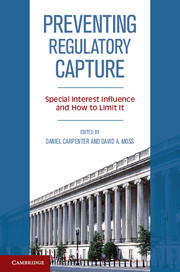Book contents
- Frontmatter
- Contents
- List of Figures
- List of Tables
- Editors
- Contributors
- Preface
- Acknowledgments
- Introduction
- Section I Failures of Capture Scholarship
- Section II New Conceptions of Capture – Mechanisms and Outcomes
- Section III Regulatory Case Studies
- Section IV The Possibility of Preventing Capture
- Conclusion
- Afterword
- Index
- References
Introduction
Published online by Cambridge University Press: 05 June 2014
- Frontmatter
- Contents
- List of Figures
- List of Tables
- Editors
- Contributors
- Preface
- Acknowledgments
- Introduction
- Section I Failures of Capture Scholarship
- Section II New Conceptions of Capture – Mechanisms and Outcomes
- Section III Regulatory Case Studies
- Section IV The Possibility of Preventing Capture
- Conclusion
- Afterword
- Index
- References
Summary
When markets or regulations fall short of our expectations, observers often point to regulatory capture as a culprit. Critics maintain that regulatory capture stunts competition and innovation, as firms able to capture their regulators effectively wield the regulatory power of the state and can use it as a weapon to block the entry or success of other firms. Some critics even blame regulatory capture for the outbreak of financial crises and other manmade disasters. Recent years provide no exception. In the wake of the global financial crisis of 2007–2009, and following catastrophes ranging from massive oil spills to mine explosions, observers seemed to find capture everywhere.
In explaining the financial crisis, for example, both left and right pounced on the reputed capture of state and federal regulatory agencies. Forbes columnist Daniel Kauffman maintained that “There are multiple causes of the financial crisis. But we cannot ignore the element of ‘capture’ in the systemic failures of oversight, regulation and disclosure in the financial sector.” Chicago economist Gary Becker pointed to an “economically disastrous example of the capture theory,” one “provided by the disgraceful regulation of the two mortgage housing behemoths, Fannie Mae and Freddie Mac, before and leading up to the financial crisis.” After the Deepwater Horizon explosion and Gulf Oil spill of spring 2010, conservative columnist Gerald P. O’Driscoll wrote in the Wall Street Journal that, “Obviously, regulation failed. By all accounts, MMS operated as a rubber stamp for BP. It is a striking example of regulatory capture: Agencies tasked with protecting the public interest come to identify with the regulated industry and protect its interests against that of the public. The result: Government fails to protect the public.”
- Type
- Chapter
- Information
- Preventing Regulatory CaptureSpecial Interest Influence and How to Limit it, pp. 1 - 22Publisher: Cambridge University PressPrint publication year: 2013
References
- 12
- Cited by

